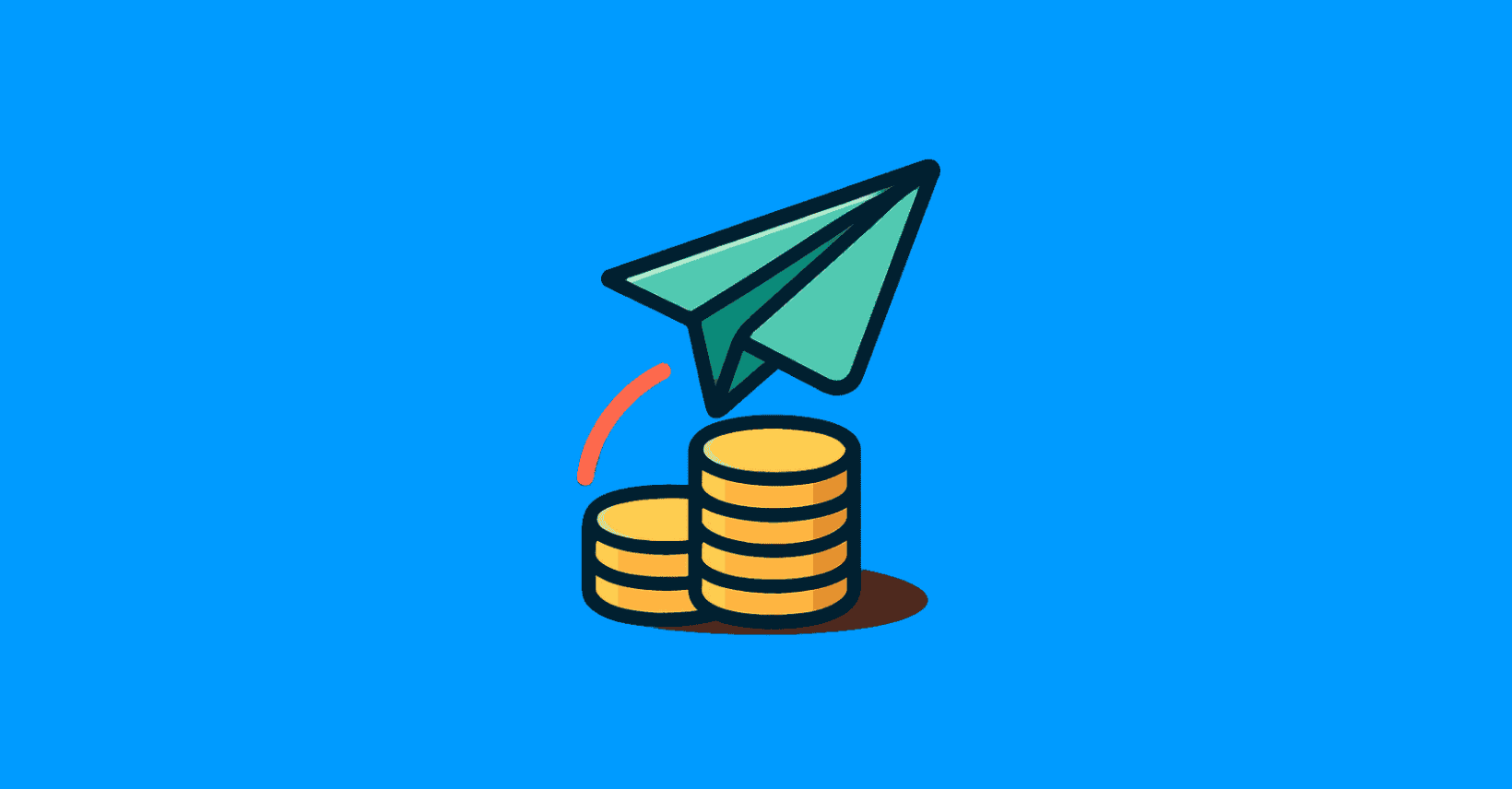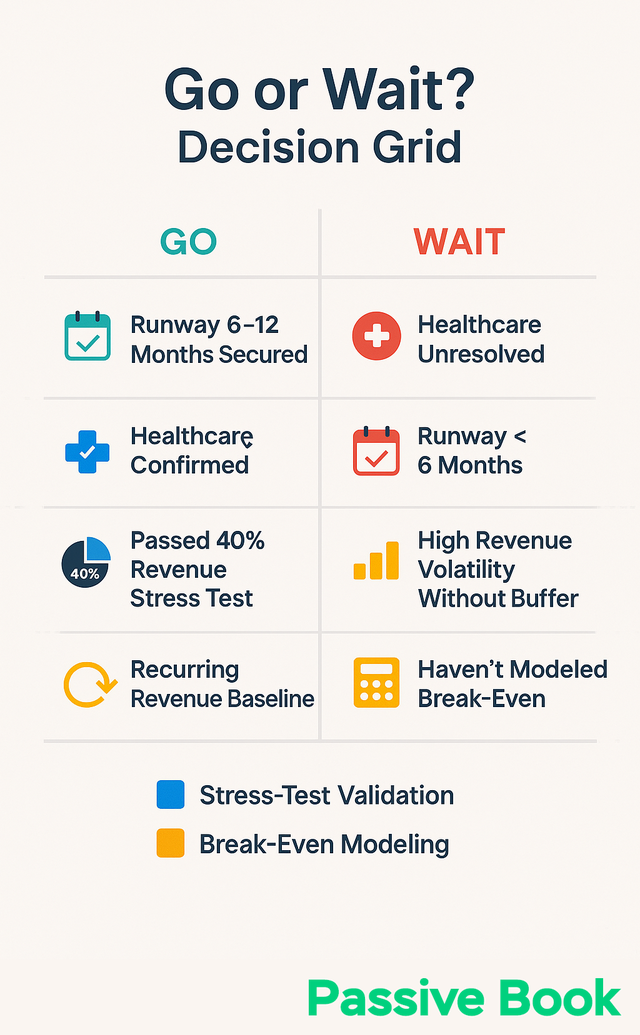I spent nearly a year checking my business bank balance every morning before my alarm went off. My side hustle was generating consistent income, but I couldn’t shake the fear of leaving my paycheck. The question keeping me up wasn’t whether my business would succeed – it was whether I’d saved enough to survive if it didn’t.
You need a specific number before you quit your full time job. That number isn’t your annual salary or your business revenue. It’s your “quit number” – the safety net every small business owner needs before leaving employment – a calculation combining your bare-minimum living costs, healthcare gaps, tax obligations, and enough runway to weather the inevitable slow months that hit every small business.

What Is a Quit Number?
Your quit number represents the total cash you need in the bank before walking away from employment. It combines your essential monthly expenses, tax obligations, healthcare costs, business operating expenses, and a multiplier for your chosen runway period.
This isn’t your gross salary or your current business revenue. Strip out everything non-essential: streaming subscriptions, dining out, hobby expenses, and discretionary travel. Francisco Rivera, an Etsy candle seller, didn’t quit until his side hustle hit six figures in sales, giving him the confidence his quit number was covered.
Most small business owners calculate this wrong. They look at their take-home pay and assume they need that amount saved.
But your full time work covers hidden costs: employer-subsidized health insurance, half your payroll taxes, paid time off, and retirement contributions. Your quit number must replace all of that from your business income and savings Buffer.
The formula looks like this: monthly essentials plus healthcare plus self-employment tax plus business costs, multiplied by your runway months. If your essentials are $3,500, healthcare is $600, taxes eat 15.3% of your net income, and your business costs $400 monthly, you need about $4,500 per month. Multiply that by 9 months and your quit number is $40,500 in liquid savings.
Who Should Use This?
Best For: This framework works best for solopreneurs running content businesses, ecommerce stores, or digital product ventures while still employed. You’ve already proven your concept works, you’re generating consistent extra income, and you’re mentally ready to scale but financially uncertain about timing.
Skip If: Skip this if your employer benefits are irreplaceable or your business income remains unpredictable month-to-month. A spouse with a stable job and comprehensive health insurance changes your risk profile entirely. If you’re managing a chronic condition requiring expensive medication, COBRA gaps might make the transition unsafe without a partner’s coverage.
Revenue Model Note: Recurring revenue creates a financial floor that makes the math easier. Patreon’s 10 million monthly active patrons demonstrate subscription models work across niches. If 100 people pay you $10 monthly, you have a $1,000 baseline before you sell a single extra product.
Churn Planning: Plan for 3-5% monthly churn in subscription models. Substack averages around 3% paid conversion from free subscribers, and Baremetrics churn data shows healthy SaaS businesses lose 3-7% of subscribers monthly. Your quit number must account for this natural attrition when calculating sustainable income.

2025 Reality Check
Healthcare costs terrify me more than revenue drops. If you get quotes from the ACA marketplace, and you will keep finding hidden costs you didn’t budget for. The monthly premium is one thing, but high-deductible plans mean paying full price for everything until hitting $7,000 out-of-pocket. Watching other solopreneurs burn through their runway on healthcare surprises they didn’t plan for taught me to budget higher than the sticker price.
Affordable Care Act marketplace premiums are rising in 2025. Budget higher monthly healthcare costs than last year, especially if you’re in a state without expanded Medicaid or if you’re over 40. Get actual quotes from HealthCare.gov during open enrollment before you set your quit number, not after you’ve already resigned.
Self-employment tax hasn’t changed: you’ll pay 15.3% of your net business income to cover Social Security and Medicare taxes your employer used to split with you. This hits before income tax, so budget it from your revenue immediately. Most new solopreneurs forget this and face a painful tax bill in April.
Payment processing fees chip away at every transaction. Stripe charges 2.9% plus $0.30 per successful card charge. A $30 sale nets you $28.13 after fees. The fee breakdown: $30 × 2.9% = $0.87, plus the fixed $0.30 fee, totaling $1.17 in fees. Those small percentages compound across hundreds of transactions, reducing your effective revenue by 3-5% depending on your average transaction size.

Find Your Quit Number
Calculating your quit number requires brutal honesty about what you actually need versus what you want. This determines whether you’re ready now or need six more months of saving.
What to Include
Start with housing, food, transportation, childcare, minimum debt payments, and only the subscriptions you genuinely need for your business. Cut everything else. Your quit number funds survival, not comfort.
Healthcare costs vary wildly by state and age. Compare COBRA continuation coverage at up to 102% of the full premium your employer was paying versus ACA marketplace plans. COBRA keeps your current doctors but expires after 18 months. ACA plans cost less but might require new providers.
Add 15.3% self-employment tax calculated on your net earnings, not gross revenue. If your business generates $50,000 after expenses, budget $7,650 for self-employment tax before calculating income tax. This catches most new full-time entrepreneurs off guard because they forget their employer used to pay half.
Platform fees reduce your take-home revenue. Etsy charges listing fees, transaction fees, and payment processing fees that total about 6.5% of each sale. Stripe takes 2.9% plus $0.30 per transaction. Budget these fees into your quit number calculation so you’re working from net revenue, not gross.
Set Months & Check
Your runway length depends on your risk tolerance and financial responsibilities. Six months covers basics, but nine to twelve months gives you breathing room to scale without panic.
Target 9-12 months if you’re the sole earner in your household. Single income families need more buffer because there’s no backup paycheck if the business hits a slow quarter. If you have a partner earning steady income, six months might be enough.
Use the SCORE break-even analysis template to validate your math. Plug in your monthly fixed costs, variable costs per unit or service, and pricing. The template shows exactly how many sales you need monthly to cover your quit number without dipping into savings.
Runway Months to Save
Financial advisors recommend six to twelve months of expenses in an emergency fund. That baseline applies to your full-time transition. Start there, then adjust based on your specific situation.
Variable income businesses need longer runways. If your monthly revenue swings from $2,000 to $8,000, nine to twelve months protects you from a string of bad months. Consistent subscription revenue lets you operate closer to six months because you can predict baseline income.
Keep an additional three months of business operating costs separate from personal expenses. This covers your web hosting, email service, inventory restocks, or ad spend without forcing you to choose between paying yourself and keeping the business running. Consider this your business emergency fund.
Store your runway money in an FDIC-insured high-yield savings account for liquidity and safety. You need instant access if an emergency hits, and you can’t afford stock market volatility when this money represents your survival buffer. Current high-yield accounts earn around 4-5% APY while keeping your funds completely liquid.
Stress-test a Bad Quarter
Revenue drops happen to every business. Model a 40% revenue decline for three consecutive months using the SCORE break-even template. If your business currently generates $6,000 monthly, can you survive on $3,600 for 90 days without depleting your entire runway?
Create two reports in Wave Accounting: a monthly profit and loss statement and a 12-week cash flow projection. The P&L; shows whether you’re profitable on paper. The cash flow report shows whether you have actual money to pay bills, which matters more when revenue drops.
Identify which expenses you can pause immediately during a downturn. Prioritize essential costs like hosting and email service over experimental tools you’re testing. Cut ad spend temporarily if your organic channels can maintain baseline sales. Most subscription tools let you downgrade or pause for a month without losing your data.
Revenue isn’t always linear. Your stress test should account for sudden spikes that refill your runway as well as sustained dips that drain it.
Go/Wait Decision Grid
Go if your essential expenses are covered for six-plus months and your total runway spans 6-12 months minimum. The CEO of an $8 billion ecommerce firm warns you could have different regrets, but financial stability removes the most common one: running out of money before your business scales.
Wait if you haven’t solved healthcare coverage. You can’t start a business if a medical emergency bankrupts you in month two. Open enrollment for ACA plans runs November through January, but you can access special enrollment periods within 60 days of losing employer coverage. Plan your resignation timing around this window.
Go if your business survives the 40% revenue stress test using the SCORE template. Your plan doesn’t need to show growth during a downturn. It just needs to show you won’t burn through your entire runway in one bad quarter.

Hard Truths & Traps
Healthcare coverage through COBRA can cost up to 102% of the full premium your employer was paying, including the portion you never saw on your paycheck. A plan that cost you $200 monthly might actually cost $850 under COBRA. Get this number from HR before you resign, not after.
Payment processing fees reduce your margins on every transaction. Budget Stripe’s 2.9% plus $0.30 per charge, plus any marketplace fees if you sell through platforms. A $50 product with 5% marketplace fees and 3% processing fees nets you about $46, not $50. Your quit number must be based on net revenue after all fees.
Quarterly estimated taxes to the IRS are due in April, June, September, and January. Miss a payment and you’ll face underpayment penalties on top of the tax you already owe. Set aside 25-30% of every payment you receive immediately, not at the end of the quarter.
Keep your emergency reserves untouched for actual emergencies. Unexpected costs appear after leaving employment: equipment failures, sudden platform policy changes requiring site updates, or personal emergencies that prevent you from working. Your runway calculation assumes everything goes reasonably well. Reality includes equipment breaking and getting sick.
Frequently Asked Questions
How Much Money Is Considered a Good Side Hustle?
Judge income after you subtract processing fees and self-employment tax. A $30 sale through Stripe nets $28.13 after the 2.9% plus $0.30 fee. Then subtract 15.3% self-employment tax ($28.13 × 0.153 = $4.30), leaving about $23.83 as actual take-home. Calculate whether your side hustle income covers your quit number using these net figures, not gross revenue.
What Is Profit First Budgeting?
Profit First is a cash management system that allocates every dollar of revenue into separate buckets: profit, owner’s pay, taxes, and operating expenses, in that order. This forces you to pay yourself and set aside taxes before spending on discretionary business costs. Open separate checking accounts or use virtual envelopes within one account to enforce the allocation discipline.
How to Save $10,000 in 3 Months?
Target $3,334 per month for 90 consecutive days to reach $10,000. Combine spending cuts of around $1,500 monthly, one-time asset sales worth $1,000, and extra side hustle work generating $834 monthly. Track every dollar in Wave to identify which expense categories you’re actually cutting versus which ones keep creeping back up.
What Next?
You now have a formula for your quit number instead of a vague feeling about when you’ll be ready. Calculate your essential monthly costs, add healthcare and taxes, multiply by your runway months, and you have a concrete savings target to work toward.
The transition from side hustle to full time won’t feel safe even when your spreadsheet says you’re ready. I had 11 months of runway saved and still felt terrified my first week. That fear is normal, but it shouldn’t paralyze you when the math proves you’re financially prepared.
Share this article with someone else weighing the same decision, using the buttons below. Then leave a comment answering this: What’s the single biggest expense concern stopping you from going full-time right now?
Share this post with your friends & followers:
